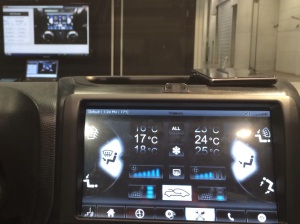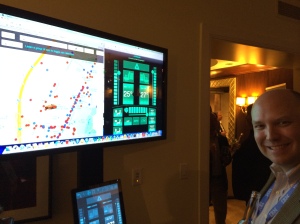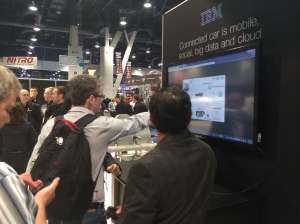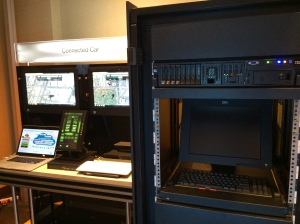Had a great time at CES 2014 showing my IoT tech with Continental AG in the Renaissance Hotel, Jaguar Land Rover + Intel at GENIVI Show Trump Tower, QNX + Qualcomm in North Hall LVCC, and IBM in the Venetian. Really enjoyed CES, GENIVI Show, Tao, and especially Firefly on Paradise with my guys. Thanks!
Spent 4 days with dozens of automakers and car system providers, fielding questions and showing live demos. Based on those discussions I’ve pulled together information I hope is useful. Or if not useful, at least interesting:
- thoughts https://mobilebit.wordpress.com/?s=mqtt
- rants https://twitter.com/search?q=%40mobilebit%20mqtt&src=typd&f=realtime
- slides http://www.slideshare.net/JoeSpeed/ibm-connected-car-is-a-big-data-problem-for-autotech-council-dec-13-2013-joe-speed
- monologue http://youtu.be/u69I-GLYd6I
- MQTT vs HTTPS on mobiles – 93x faster, 11x less power to send, 170x less power to receive, 8x less network overhead. QoS and LWT for reliable comms on unreliable networks.
- IBM MessageSight – secure IoT appliance and core component of global IBM IoT Cloud on Softlayer. Concurrently connects 21M vehicles & mobiles at up to 340.2M telematics messages/second per rack. Low latency, 60μs device-to-device MQTT messaging on fast network (i.e. 10GigE) under load.
- video of AT&T iPhone & Verizon iPad remote control of GENIVI Tizen HVAC, note the low latency Scottsdale > Dallas cloud > car in MA changes temp > Dallas > Scottsdale https://twitter.com/MobileBit/status/423181215672188928
- demos, how-to examples and source code http://m2m.demos.ibm.com/
- demo video using QNX TI OMAP5 car http://youtu.be/C3ebGjJ0KjM?t=1m21s
- another demo https://www.dropbox.com/s/lfjuih5v3928cg6/JLR_IBM_Intel_GENIVI_Tizen_demo.mov or even better is this one https://www.dropbox.com/s/a4rqm7nnw8tzxgk/JLR_Tizen_IBM_IoT_720p.mov
note the data path for what you’re seeing in the 2 side-by-side HTML5 apps is Verizon iPad Scottsdale AZ > Dallas Softlayer cloud > GENIVI Tizen car unit in Dartmouth MA > Dallas Softlayer cloud > AT&T iPhone Scottsdale AZ - try this MQTT HTML5 whiteboard demo on several mobiles side-by-side, and observe the latency. http://m2m.demos.ibm.com/whiteboard/ This is running against Softlayer’s Dallas cloud in North America. Let me know if you need the URLs for this in Asia, Europe or elsewhere.
- MQTT + MQTT-SN simplifies V2V / V2X. MQTT for V2V via cloud 10s-100s ms, MQTT-SN for V2V via DSRC, ZigBee, 6LoWPAN, serial, UDP, et al. And Eclipse Mosquitto RSMB 1.3 is 75KB MQTT + MQTT-SN broker for embedded that bridges V2V mesh to cloud. I think it wouldn’t be an exaggeration to say that RSMB is battle hardened.
- MQTT/MQTT-SN for transport independent V2V/V2X via dynamic mesh of DSRC/WAVE, Wi-Fi, LTE-A, cloud a’la ITA’s MQTT Sensor Fabric https://twitter.com/MobileBit/status/423877657118261248
- Yes, the cloud is too slow to tell me the car ahead hit their brakes. For that you need 20ms latency. But you know what else besides DSRC can do that? Cameras, radars, lasers, many things. And DSRC doesn’t help with what’s around the next bend, what’s over the next hill. It is very localized. Which is an issue because there is a whole class of V2V problems that require macro-level awareness and real-time decisioning for which higher latency (100ms+) is acceptable. Continental is public example of someone that tackling those using IoT + real-time Big Data geospatial decisioning in the cloud.
- Yes, not every car is connected nor will they be in the near term, so what about the blind spots? There are things that help mitigate that. For example if a car senses other cars and publishes that data to the cloud, then the cloud knows about those cars even though they’re not connected. IoT MQTT cloud connectivity is software, just requires is a programmable TCU. Ford already made public that they’re pushing an OTA update to 3.4M existing cars adding more connected car capabilities, so many existing models can enabled for V2V cloud, not just future ones. Automakers are launching aftermarket OBD2 dongles such as this one w 3G/GPS/accelerometers/etc. are $100 and less at retail ($20 in volume for an OEM?) that cloud connect via MQTT any car built after 1995.
- Yes, it is an issue there that each OEM is having their own cloud. Solutions include having them use 1 cloud, for example what Continental AG is doing with having IBM give them the global connected car cloud which will be used by multiple OEMs that they supply. Can also tackle it via federated car clouds, interconnecting them and exchanging data in real-time. While not trivial, federated clouds and federated ESBs is fairly well traveled ground. The technology is there. MQTT even has a bridging convention whereby an MQTT broker (server) can also be a client. The same approach you use to have an MQTT broker like RSMB in the car bridging a local V2V mesh to the cloud can also be used to bridge one cloud to another, effectively interconnecting them. Yes that requires agreement re data format (preferably protobuf or JSON) and topic space, but those are solvable.
- I’ve nothing against DSRC, in fact I’m very excited to have MQTT-SN running atop DSRC/WAVE, I think the pub/sub topics and QoS adds to DSRC’s usefulness. That said, DSRC is early 90’s RF tech that is beginning to show its age. And many of the use cases DSRC was intended for in V2V are becoming obviated by other sensor and wireless tech. I don’t need DSRC to tell me when the car ahead hits their brakes, the car is already getting several other sensors that can do that. And nobody has figured out where the $3 trillion dollars is going to come from to get DSRC radios into all the cars and infrastructure. And we’re talking about adding that DSRC cost to cars that are already getting LTE Advanced and/or WiFi. You know what else besides DSRC can do peer 2 peer? LTE Advanced and WiFi. Credit for this to Roger Lanctot @rogermud who clued me into this. He’s also the one that pointed out to me that latency is a driver distraction issue.
- I already knew latency is an owner satisfaction and brand perception issue. She’s not going to buy your car if her buying experience includes making her standing in the rain for 30 to 90 seconds while pondering her request to unlock the doors.
- MQTT client source http://eclipse.org/paho/ for C, C++, Java, JavaScript, Python, Lua
- MQTT + MQTT-SN bridging broker for embedded systems. http://mqtt.org/2013/12/mqtt-for-sensor-networks-mqtt-sn
- MQTT-SN “MQTT for Sensor Networks” is designed for WSNs and mesh networks using datagrams instead of socket. It works over DSRC, ZigBee, 6LoWPAN, LTE Advanced p2p, UDP, et al. Like MQTT it is open standard, open source and royalty free. Some think it can greatly improve V2V / V2X by making it publish/subscribe based and transport independent (like the military’s). The meshing capabilities and ability to propogate topics and messages across the mesh w QoS is really quite amazing. I’m trying to get permission to youtube the videos form the field trials. http://mqtt.org/2013/12/mqtt-for-sensor-networks-mqtt-sn
- MQTT Sensor Fabric secure WSN mesh used by US and UK military uses RSMB which is now open source per above.
- MQTT 3.1 spec http://mqtt.org/documentation
- MQTT 3.1.1 spec draft https://www.oasis-open.org/news/announcements/30-day-public-review-for-mqtt-version-3-1-1
- MQTT-SN 1.2 spec http://mqtt.org/new/wp-content/uploads/2009/06/MQTT-SN_spec_v1.2.pdf
- Q: Is MQTT security better or worse than HTTPS? A: Neither. It is the same. They are both socket protocols that rely on TLS/SSL connection level encryption. For example to the cloud I often suggest TLS 1.2 w mutual authentication using “signed at the foundry” keys built into the chipset.




